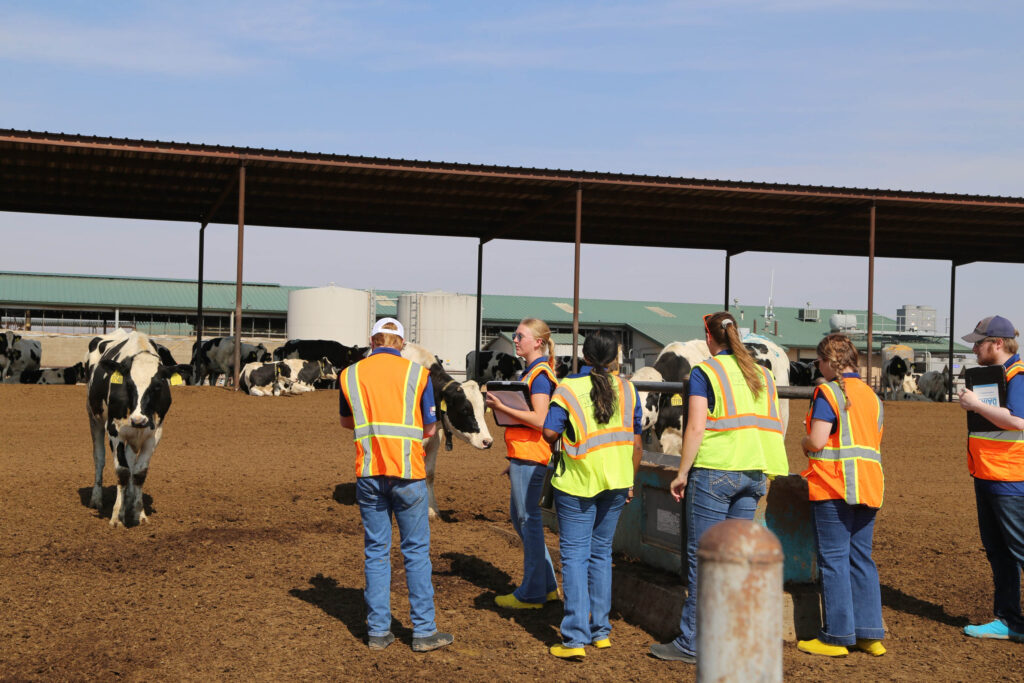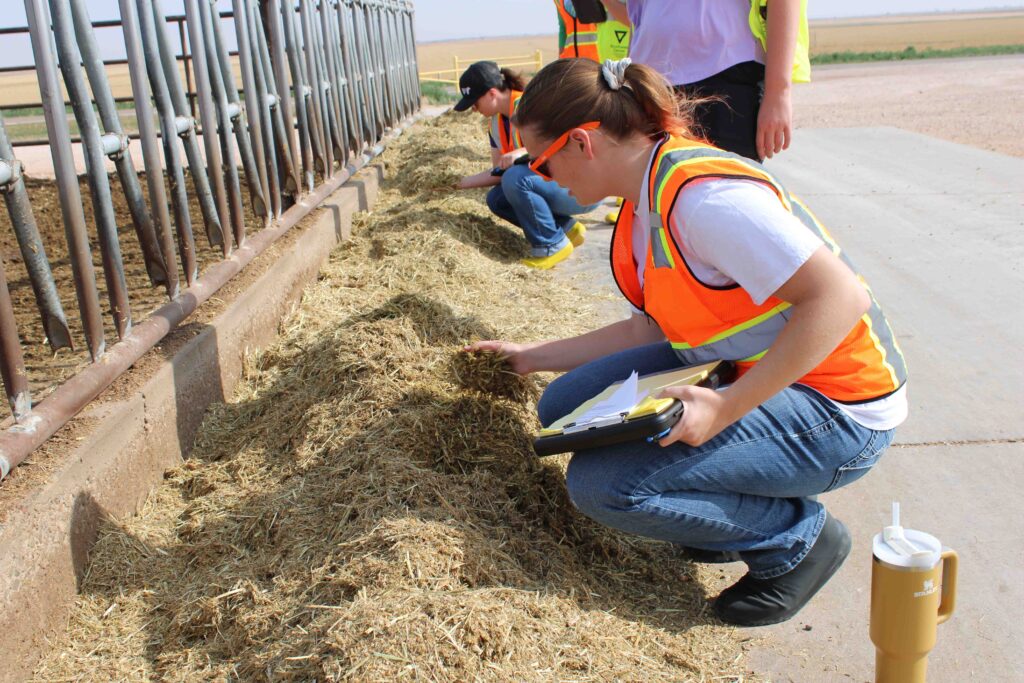Connecting students to the dairy industry
U.S. Dairy Education and Training Consortium offers unique educational opportunity for future industry leaders
Abby van Adrichem is a dairy farm girl from Hereford, but even with her experiences growing up, she knew she didn’t know the dairy business like she needed to.
As a sophomore animal science major with a minor in agricultural economics in the Texas A&M College of Agriculture and Life Sciences Department of Animal Science, van Adrichem found a unique opportunity to expand her knowledge – the U.S. Dairy Education and Training Consortium.

“Even though I am from that background, the consortium exposed me to aspects of dairy farming I was unfamiliar with,” she said. “It let me explore industry areas I didn’t really see on the family side. Students from other states and countries exposed us to different perspectives.”
The consortium has been described by industry experts as “the best program out there connecting students to the dairy industry.” It is considered a model to teach modern dairy management with limited resources by capitalizing on the support of agribusiness and dairy producers.
The dairy consortium started in 2008 because there was a dire need, said Michael Tomaszewski, Ph.D., Texas A&M AgriLife Extension Service specialist emeritus, professor and academic coordinator for the consortium in the Department of Animal Science. There were not enough dairy science educational programs at land-grant universities from the southern and western regions of the U.S., and students were losing the opportunity to learn practical experience about the industry.
“This program has been something that started as a dream and is now recognized on a national basis as an example of how to provide students access to modern dairy management practices and opportunities,” Tomaszewski said.
“It is only possible with the support of dairymen allowing us to come onto their dairies,” he said. “By partnering with working dairies, we can allow students to see the latest dairy technologies. The curriculum is continually updated to stay current with dairy management and technology.”
A need to educate future industry leaders
In the early 2000s, the Texas Panhandle experienced rapid expansion in the number of dairy cows to meet rising demand for milk by new processing facilities in the region, which meant the industry needed trained individuals, Tomaszewski said.

“In the mid-2000s, we formed a committee at Texas A&M to look at opportunities to provide a dairy program in light of the increased demand by producers and processors for individuals to help in their new operations and facilities,” he said. “We also wanted to provide a basis for students interested in veterinary careers or advanced degrees in dairy science.”
The idea was born to host an intensive six-week course in a production area with access to facilities. Outstanding individuals from academia and industry would provide course content.
With the help of Robert Hagevoort, Ph.D., co-coordinator and New Mexico State University Extension dairy specialist, and Bob Collier, Ph.D., who at that time was looking for a way to provide dairy courses to students at Arizona State University, the Clovis, New Mexico, region was selected.
The team found a motel to provide discounted housing for students. The Clovis Community College would provide classrooms and laboratories, and New Mexico State University could provide transport vans for students.
The first year, offered at no cost to the students, attracted 18 students, eight from Texas A&M.
Growing a successful program
The program received a U.S. Department of Agriculture grant in 2010, which provided funding for three years of the consortium. Since that time, Tomaszewski said they have continued to receive agribusiness support, which allows the program to be provided at minimal cost to students.
“As to the program’s success, our students speak for our success,” he said.
Results from a graduate survey were published as an abstract in the Journal of Dairy Science, with respondents reporting 81% remain in agriculture, 28% work at a dairy, 24% in a dairy-related industry and 15% became veterinarians.
The consortium has had 1,045 applications, with 396 from Texas A&M. Of those, 711 students attended the summer program, with 250 coming from Texas A&M and another 50 from Texas A&M affiliates West Texas A&M University and Tarleton State University. Other states consistently sending students include New Mexico, Arizona, Florida, Idaho and Washington.
Due to increased applications, two concurrent sessions were initiated in 2012, with class size limited to 30 students in the introductory session and 20 students in the advanced session.
“We wanted to keep class size manageable, so students had the opportunity to be deeply involved when we went to a dairy,” Tomaszewski said. “Each day has classroom instruction coupled with a dairy visit to reinforce what was discussed in the classroom.”
The consortium has changed the lives of many students by exposing them to opportunities in dairy science and the technology used in dairy, which outstrips any other livestock enterprise, he said.
Department provides expertise
The Department of Animal Science has also expanded its role as an educator within the program. Faculty representation increased on its expert panel in 2018-2019 when they hired three new dairy-related faculty members: Sushil Paudyal, Ph.D., assistant professor; and Texas A&M AgriLife Extension Service dairy specialists Juan Piñeiro, DVM, Ph.D., assistant professor, Amarillo, and Jennifer Spencer, Ph.D., assistant professor, Stephenville.

Piñeiro spends his time at the consortium teaching the best nutrition and management strategies to prevent diseases in dairy cows after calving, along with other guest lecturers and his doctoral student Douglas Duhatschek, DVM. He helps obtain and prepare materials used for hands-on laboratory activities and takes students to help with various activities.
Spencer spends her time during the consortium helping teach reproduction, assisting with labs, and providing “office hours” to help students understand lectures.
Paudyal helps with student recruitment, the application process and evaluation, and daily activities during the consortium. Students can receive four discipline-specific course credit hours from the consortium, and it also fulfills their Animal Science Experience requirement on their degree plan.
Impact on students
“When the students come back to campus after the program, they talk to us about how the concepts discussed in the program have helped them succeed in the courses they take here such as nutrition and reproduction,” Paudyal said.
And that excitement has carried over to dairy-related activities on campus. The dairy science club, which had five or six people in 2019, now has around 45 members largely due to students getting exposed to the industry through the consortium, he said.
“We’ve also seen a significant increase in undergraduate student senior-level capstone projects being conducted in topics related to the dairy industry, indicating a significant increase in interest in the dairy industry among the student population,” he said.
Paudyal also coordinates the departmental competitive team, the Dairy Challenge Team. In recent years, the team members have all come from the consortium. The team attributes their success to the experience and exposure they have received during the consortium.
“This is the most comprehensive, condensed and practical dairy education program in the U.S.,” Piñeiro said. “No other formal program allows students to acquire such holistic knowledge of the dairy industry, from nutrition to reproduction, genetics, herd health management, welfare and economics, in only six weeks, or that visits as many dairies, feed mills, milk processing plants, calf ranches and has as many laboratories and hands-on practice activities as the consortium offers.”
Education like no other
Van Adrichem said she wants to return to the dairy consortium for the second part next summer. She explained the first session of the consortium is about science – nutrition, reproduction, health – and the second session is about business – the economics and management.
Students attend classes Monday through Saturday to hear from national experts on various topics. Company-sponsored lunches allow representatives to talk about internships and job opportunities. The hands-on portions and visits to different styles of dairies are after lunch. Many of their speakers and people they meet on the farms are graduates of the consortium.
“In the evening, we would hang out and share stories, creating the bonds the consortium is known for,” van Adrichem said. “We had deep conversations about dairy cows and how they perform. The professors guided us through the lessons and explained the concepts in a very basic way. And then we were able to apply the knowledge, which is not something you get to experience in a classroom.”
The friends made, she said, will be her peers in the industry moving forward. Those will be so important as well as the connections with experts that students were able to meet and now have as a reference for questions and concerns.
“This is invaluable for the future of the industry,” van Adrichem said. “I feel like the dairy industry needs leaders. After the consortium, students are much more knowledgeable, so the efforts to build leadership are working.”





